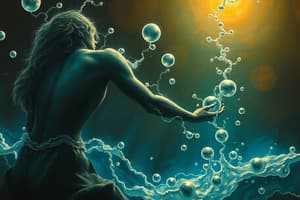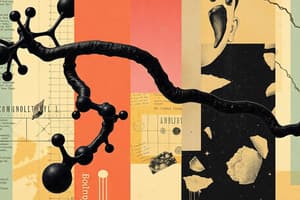Podcast
Questions and Answers
What is the role of the active site in an enzyme?
What is the role of the active site in an enzyme?
- It prevents competitive inhibitors from attaching.
- It is the region where substrates bind and undergo a chemical reaction. (correct)
- It alters the enzyme's overall shape.
- It determines the enzyme's protein folding.
Which factor does NOT affect enzyme activity?
Which factor does NOT affect enzyme activity?
- Presence of competitive inhibitors
- Type of substrate (correct)
- pH levels
- Temperature
How do enzymes lower activation energy in biological reactions?
How do enzymes lower activation energy in biological reactions?
- By increasing the temperature of the reaction.
- By removing energy from the substrates.
- By altering the concentration of substrates.
- By providing an alternative reaction pathway. (correct)
What is a consequence of denaturing an enzyme?
What is a consequence of denaturing an enzyme?
Why is glucose catabolism not a single-step process?
Why is glucose catabolism not a single-step process?
Which of the following best describes the induced fit model?
Which of the following best describes the induced fit model?
What is one reason why all living organisms require a constant input of energy?
What is one reason why all living organisms require a constant input of energy?
What effect do noncompetitive inhibitors have on enzyme activity?
What effect do noncompetitive inhibitors have on enzyme activity?
What is the main purpose of glycolysis in cellular respiration?
What is the main purpose of glycolysis in cellular respiration?
What role do NADH and FADH2 play in the electron transport chain?
What role do NADH and FADH2 play in the electron transport chain?
Which of the following best describes the Krebs cycle's starting molecule?
Which of the following best describes the Krebs cycle's starting molecule?
How does fermentation help cells under anaerobic conditions?
How does fermentation help cells under anaerobic conditions?
In photosynthesis, what is the function of chlorophyll?
In photosynthesis, what is the function of chlorophyll?
What is produced during the Light Dependent reactions of photosynthesis?
What is produced during the Light Dependent reactions of photosynthesis?
Why are ATP and NADPH essential in the Calvin Cycle?
Why are ATP and NADPH essential in the Calvin Cycle?
Which pathway is an adaptation for plants in arid environments to fix carbon efficiently?
Which pathway is an adaptation for plants in arid environments to fix carbon efficiently?
Flashcards
Enzyme Specificity
Enzyme Specificity
An enzyme's specific three-dimensional shape, allowing it to bind only to specific substrates.
Active Site
Active Site
The region on an enzyme where the substrate binds, facilitating the chemical reaction.
Denaturation
Denaturation
The process of changing an enzyme's shape, often by heat or extreme pH, making it lose its function.
Activation Energy
Activation Energy
Signup and view all the flashcards
Catalyst
Catalyst
Signup and view all the flashcards
Metabolic Pathway
Metabolic Pathway
Signup and view all the flashcards
Energy Coupling
Energy Coupling
Signup and view all the flashcards
Cellular Respiration
Cellular Respiration
Signup and view all the flashcards
Chemical gradient
Chemical gradient
Signup and view all the flashcards
How glycolysis releases energy
How glycolysis releases energy
Signup and view all the flashcards
Pyruvate oxidation
Pyruvate oxidation
Signup and view all the flashcards
Krebs cycle
Krebs cycle
Signup and view all the flashcards
Role of NADH and FADH2
Role of NADH and FADH2
Signup and view all the flashcards
ETC and Proton Gradient
ETC and Proton Gradient
Signup and view all the flashcards
Fermentation
Fermentation
Signup and view all the flashcards
ATP hydrolysis
ATP hydrolysis
Signup and view all the flashcards
Study Notes
Unit 3: Cells - Topic List Study Notes
-
Topic 3.1 - Enzyme Structure (Ch. 8):
- Enzymes are proteins.
- Enzymes have an active site.
- Enzymes have an allosteric site (possibly).
- Enzyme structure includes protein folding.
- The substrate's shape and charge are specific to the enzyme it binds to.
- The induced fit model describes how the enzyme changes shape when the substrate binds.
-
Topic 3.2 - Enzyme Catalysis (Ch. 8):
- Enzymes speed up chemical reactions.
- Activation energy is lowered with enzymes.
- Enzymes act as catalysts.
-
Topic 3.3 - Environmental Impacts on Enzyme Function (Ch. 8):
- Enzyme structure affects function.
- Denaturation changes enzyme shape and reduces activity.
- Substrate specificity means each enzyme works with a particular substrate.
- Cellular environment factors (pH, substrate/enzyme concentration, temperature) impact enzyme activity.
- Competitive and noncompetitive inhibitors affect enzyme activity.
-
Topic 3.4 - Cellular Energy (Ch. 8):
- Living things need continuous energy input.
- Metabolic pathways release energy in series of reactions.
- Breaking down glucose in a single step is inefficient.
- The second law of thermodynamics cannot be violated.
-
Topic 3.6 - Cellular Respiration (Ch. 9):
- Organisms use energy from biological macromolecules.
- Cellular respiration or fermentation is used for energy.
- Energy coupling uses electrochemical gradients.
- Glycolysis releases energy to form ATP and NADH.
- Pyruvate oxidation prepares pyruvate for the Krebs cycle.
- The Krebs cycle breaks down Acetyl-CoA releasing energy and CO2, producing ATP.
-
Topic 3.5 - Photosynthesis (Ch. 10):
- Photosynthesis evolved in organisms.
- Light dependent reactions convert light energy to chemical energy (NADPH and ATP).
- The Calvin cycle uses NADPH and ATP to produce carbohydrates.
- Chlorophyll is key to capturing light.
- Photosynthesis helps plants use light for energy and convert it into a transferable energy form.
- Different plants have different pathways for carbon fixation (C3, C4, CAM).
-
NADH and FADH2:
- NADH and FADH2 are electron carriers in the electron transport chain.
- The electron transport chain creates an electrochemical gradient used to produce ATP.
- Fermentation is used when oxygen is not available, producing ATP in small amounts.
Studying That Suits You
Use AI to generate personalized quizzes and flashcards to suit your learning preferences.




